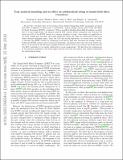Trap Assisted Tunneling and Its Effect on Subthreshold Swing of Tunnel FETs
Author(s)
Sajjad, Redwan Noor; Chern, Winston; Hoyt, Judy L; Antoniadis, Dimitri A
DownloadTrap Assisted Tunneling and Its Effect on Subthreshold Swing of Tunnel FETs.pdf (861.9Kb)
OPEN_ACCESS_POLICY
Open Access Policy
Creative Commons Attribution-Noncommercial-Share Alike
Terms of use
Metadata
Show full item recordAbstract
We provide a detailed study of the oxide- semiconductor interface trap assisted tunneling (TAT) mechanism in tunnel FETs to show how it contributes a major leakage current path before the band-to-band tunneling (BTBT) is initiated. With a modified Shockley-Read-Hall formalism, we show that at room temperature, the phonon assisted TAT current always dominates and obscures the steep turn ON of the BTBT current for common densities of traps. Our results are applicable to top gate, double gate, and gate-all-around structures, where the traps are positioned between the source-channel tunneling regions. Since the TAT has strong dependence on electric field, any effort to increase the BTBT current by enhancing local electric field also increases the leakage current. Unless the BTBT current can be increased separately, calculations show that the trap density Dit has to be decreased by 40-100 times compared with the state of the art in order for the steep turn ON (for III-V materials) to be clearly observable at room temperature. We find that the combination of the intrinsic sharpness of the band edges (Urbach tail) and the surface trap density determines the subthreshold swing.
Date issued
2016-09Department
Massachusetts Institute of Technology. Department of Electrical Engineering and Computer Science; Massachusetts Institute of Technology. Microsystems Technology LaboratoriesJournal
IEEE Transactions on Electron Devices
Publisher
Institute of Electrical and Electronics Engineers (IEEE)
Citation
Sajjad, Redwan N., et al. “Trap Assisted Tunneling and Its Effect on Subthreshold Swing of Tunnel FETs.” IEEE Transactions on Electron Devices, vol. 63, no. 11, Nov. 2016, pp. 4380–87.
Version: Original manuscript
ISSN
0018-9383
1557-9646